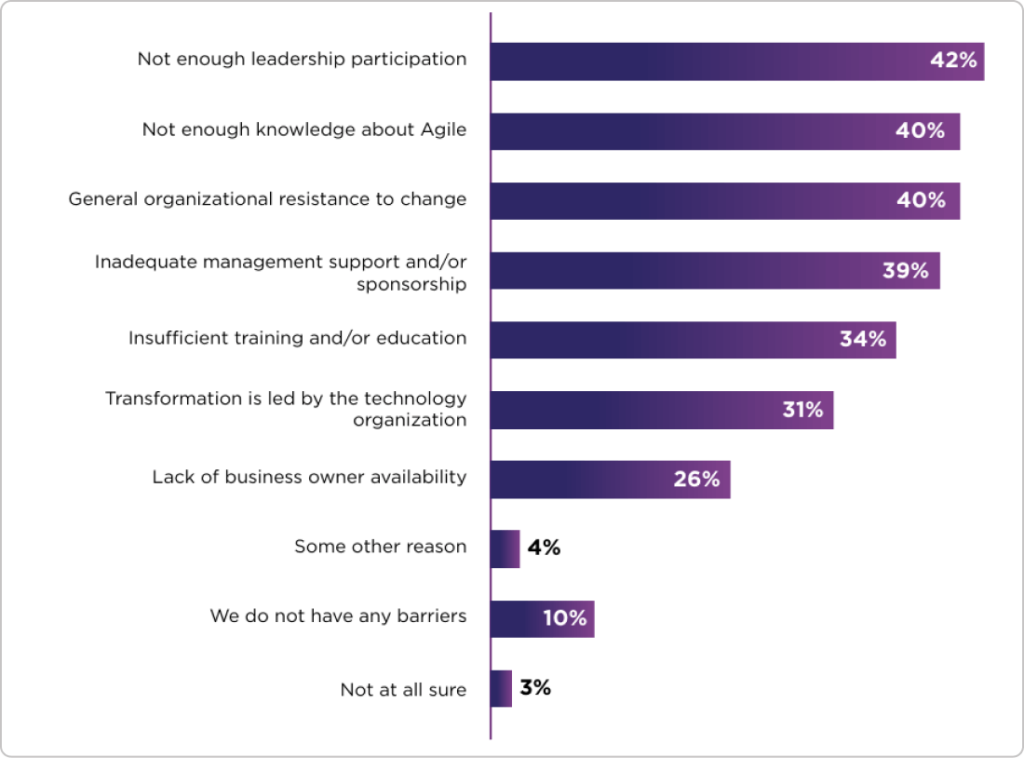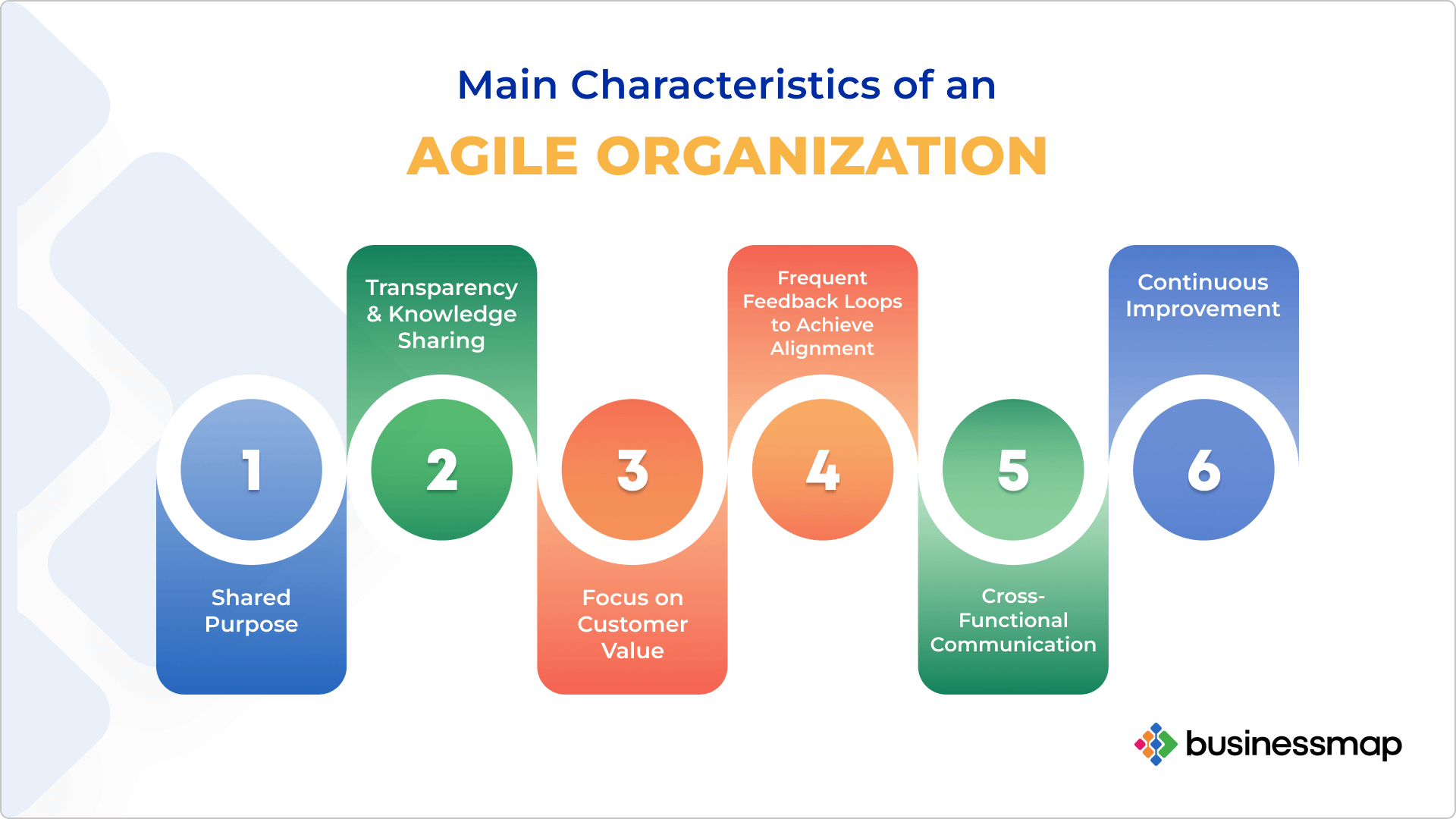Spotify's Agile transformation stands out for its unparalleled innovation and product development. The uniqueness lies in their careful evaluation of their culture and strategic implementation of Agile across their organization, leading to collaborative autonomous teams. This metamorphosis cultivated a culture of creativity, enabling rapid product iterations, continuous user experience improvement, and a sustained competitive edge in the digital music industry.
However, no transformation is without challenges. Embracing Agile principles demands awareness of potential pitfalls that may hinder progress and derail the transformation.
Let’s explore ten common mistakes organizations should be vigilant about, ensuring a smooth and triumphant transition to an Agile way of working. By learning from these missteps, leaders and teams can foster a culture of agility, empowering them to thrive in today's rapidly changing business landscape.
Why Do Agile Transformations Fail?
Despite a growing focus on aligning strategic goals with business value, the biggest group of the respondents of the State of Agile Report demonstrate a desire to achieve enterprise agility but are slow to adopt it. The reasons, of course, vary. However, culture, leadership, and Agile knowledge seem to be coming up repeatedly as challenges in the face of Agile transformation initiatives.
 Image credit: State of Agile report
Image credit: State of Agile report
10 Mistakes to Avoid for a Successful Agile Transformation
Let’s explore 10 of the most common mistakes that lead to failed Agile transformation initiatives, loss of time, budget, resources and overall inefficiencies for the business.
1. Lack of Leadership Support
To achieve business agility, companies must address the leading challenges of resistance to change and inadequate leadership management. (Source: The Business Agility Report) Success in this endeavor requires the full commitment of leadership to any Agile initiative. However, to be effective, the leadership role must adapt and evolve beyond traditional legacy leadership styles. Despite this, recent statistics on Agile adoption indicate that only 32% of business leaders are actively leading company-wide Agile transformations.
Agile leaders must be mindful, listening, empowering, and supportive of their teams on their journey to continuous improvement. It’s important that they provide their full endorsement of the initiative by adapting their management style to suit the needs of the Agile teams and foster a collaborative environment. This entails clear communication, embracing experimentation, and acknowledging every opportunity to improve.
2. Insufficient Knowledge and Understanding of Agile
Not understanding why we do what we do puts every transformation effort on the fast track to failure or, at best, to short-lived success. Cultural issues are cited as the leading challenge for close to half of the organizations to adopt Agile successfully. (Source: State of Agile Culture)
In this light, the need for providing training and resources to help employees and management understand and apply different Agile methodologies is crucial for adopting Agile. Agile coaching and the adoption of Agile tools are also widely employed methods to make the Agile mindset prominent and nurture a culture.
3. Lacking Adaptability
In 2002, the National Programme for IT in the National Health Service (NHS) was launched to digitally transform taxpayers' experience by implementing electronic patient records and prescription systems, among other initiatives. However, the initiative ultimately failed due to a lack of clear direction and an adaptive culture.
To prevent costly initiatives failure, management must foster a culture that embraces Agile principles and practices and encourages cross-collaboration and continuous improvement. By establishing feedback opportunities and providing collaboration channels, Agile can help make internal cooperation seamless and foster a behavior of open knowledge-sharing and feedback exchange.
4. Unclear Communication of the Goal
Lack of alignment with the goal of the adoption brings out another problem with the Agile transformation success rate – lack of consistency and use of unclear communication. Effective communication strategies should be used to ensure all team members understand the objectives and benefits of Agile transformation.
Besides being one of the key traits of Agile organizations, the lack of a well-defined and shared goal makes it challenging to prioritize work, allocate resources efficiently, and make informed decisions. Teams may also struggle to understand the desired outcomes and may end up delivering work that does not contribute to the transformation's success. To avoid failure, leaders need to articulate a clear and compelling vision, ensuring that all members of the organization understand the purpose behind the Agile transformation and are united in their pursuit of success.
 Key Agile organization characteristics
Key Agile organization characteristics
5. Lack of Self-Reliant Teams
Research on large-scale Agile transformation indicates the essential role and impact of team-level practices for a successful Agile roll-out. (Source: Association of Information Systems)
When teams lack self-reliance, they may become overly dependent on management for decision-making, slowing down the Agile process and stifling creativity and innovation. Moreover, without collaboration, information flow becomes constrained, leading to silos and a lack of cross-functional knowledge and expertise sharing.
Creating cross-functional teams that foster autonomy and collaboration, which are essential for a successful Agile transformation. To assemble efficient teams, management can start by visualizing the interdependencies and try to optimize them.
6. Not Recognizing and Addressing Organizational Roadblocks
Adding organizational barriers can be a critical problem leading to the failure of an Agile transformation. Agile methodologies require a flexible and adaptive environment, but organizational barriers, such as rigid hierarchies, cumbersome approval processes, and lack of communication channels, can impede progress. These barriers create bottlenecks and hinder the flow of information and decision-making, preventing teams from responding quickly to changing market demands.
Additionally, these roadblocks may generate frustration and demotivation among team members, undermining the core values of Agile, which emphasize empowerment and continuous improvement. Organizations must proactively identify and dismantle these barriers to ensure a successful Agile transformation, fostering a more agile and adaptive culture that empowers teams to thrive.
7. Not Tracking and Measuring Progress
Lack of metrics and measurement can be a significant problem leading to the failure of an Agile transformation. In Agile, data-driven decision-making is crucial to foster a state of mind driven by continuous improvement. Without clear metrics, it becomes challenging to assess the effectiveness of Agile practices, identify areas of improvement, and track progress toward goals.
Furthermore, the absence of objective data can lead to ambiguity and subjective judgments, hindering the ability to make informed adjustments and validate the impact of Agile initiatives. Moreover, without proper measurement, it becomes difficult to showcase the value of the Agile transformation to key stakeholders, potentially resulting in reduced support and resources for the initiative.
To ensure a successful Agile transformation, organizations must establish relevant and meaningful Agile metrics, regularly collect and analyze data, and use these insights to drive continuous improvement and demonstrate the tangible benefits of Agile practices.
8. Not Acknowledging the Power of Continuous Value Delivery
Going back to the roots of Agile software development, the Agile Manifesto centers around iterations, where small increments of work are continuously delivered, evaluated, and refined based on feedback. If organizations fail to adopt this “continuous” mindset, they risk falling back into traditional, linear project management methods that delay the delivery of value and limit opportunities for improvement.
When value is revealed only at the end of a project, the risk of substantial deviations from stakeholder expectations and market needs increases. This lack of regular feedback and course correction can result in wasted efforts and resources on the wrong path.
In contrast, taking an agile approach to continuous delivery empowers teams to adapt, pivot, and optimize throughout the entire process, fostering ongoing learning, delivering incremental value to customers, and establishing a culture that encourages experimentation.
“The agile transformation made us evolve into an organization that forms teams based on treatments or patient groups, identifies the needs of patients, and makes optimal decisions. “출처 : KBR (https://www.koreabiomed.com)
9. Agile Practices Stay Local
It turns out that scaling Agile practices across larger organizations and multiple teams is one hell of a challenge. As prosaic as it may sound, Agile has been conceived as a way for self-contained teams and small projects to address the challenges of changing customer requirements. The two crucial arguments are the lack of company-wide cultural change and the ability to sustain the change.
Indeed, large-scale Agile transformations involve many teams, departments, and functional business areas with different work dynamics and routines. In this type of diverse environment, being consistent becomes a challenge. Agile scaling frameworks can be of great use to convey the Agile message across. However, the best course of action is to tailor a methodology to reflect your specific organizational needs and requirements. (Source: The Agile Success Model)
10. Not Listening to Feedback
Finally, encouraging a mindset of continuous improvement at all levels of the organization is what makes business sustainability stick. Currently, organizations are facing changes at a pace that can’t be matched historically. Rapidly emerging and highly disruptive technologies, fierce competition, and growing customer requirements are at the top of the list. This volatility level requires businesses to stay alert and adaptive to the environment.
By embracing regular feedback meetings, organizations foster a culture of open communication and idea-sharing and position themselves as potential innovators, ready to seize the next ample opportunity. Agile practices encourage the exchange of observations, suggestions, and thoughts, nurturing an environment that thrives on collaboration and continuous improvement. This dynamic approach sets the stage for transformative innovation and propels the organization toward greater success.
Going Agile
As you embark on your Agile transformation journey, remember that challenges may vary and extend beyond this list. It's essential for management to understand that Agile isn't a one-size-fits-all solution, but when harnessed effectively, it can empower teams to work more meaningfully, driving impressive business results.

Iva Krasteva
Content Strategist | Agile Practitioner | Kanban Certified
Iva is a Kanban-certified Agile expert with hands-on experience in SEO, content creation, and Lean practices. She has published dozens of articles on Lean, Agile, and Kanban practical applications. Iva actively promotes collaborative, flexible work environments and regularly shares process optimization insights through writing.



